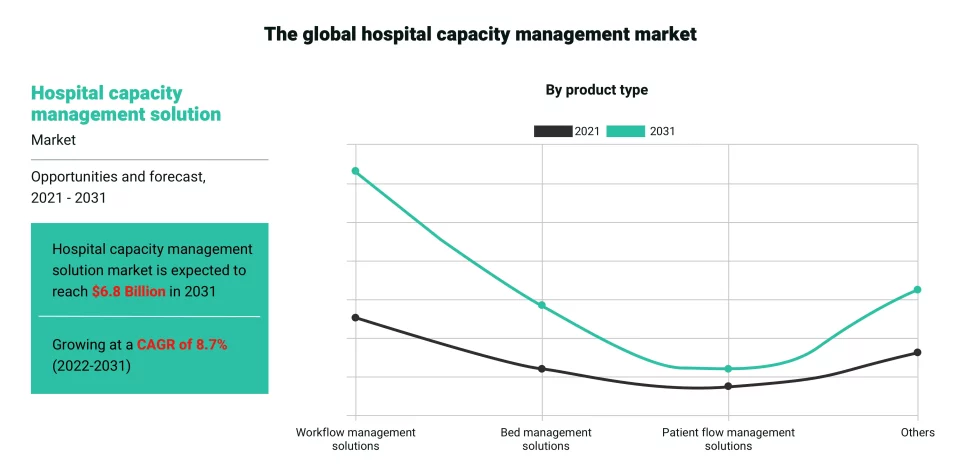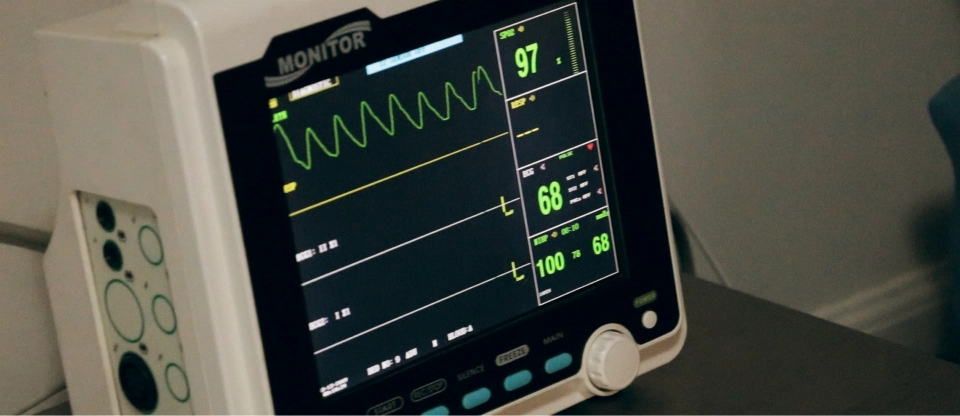INTRODUCTION
Need for advanced analytics in hospital capacity management
What is the lasting impression most of us have of hospitals in the US, especially those large super-specialty healthcare hubs where patients throng in thousands - not necessarily during public health emergencies like COVID-19?
- Lack of beds
- Over-crowded emergency rooms
- Disrupted patient flow
- Messy discharge coordination
- Confusion in scheduling
- Long queues at in-hospital pharmacies
- Over-worked staff
In all, an overwhelmed healthcare system, right? The fact, however, is that most hospitals suffer from poor capacity management and, consequently, under-utilization of available resources. Real-time analytics can provide accurate information flows, enhance scheduling, improve visibility, and optimize demand forecasting tools to handle inefficiencies in hospital capacity management.
DEFINITION
Capacity management helps to fulfill patient needs better
Given that the global demand for hospital services exceeds capacity, optimum capacity management may be defined in general terms as the best possible performance of the hospital in terms of productivity, output, or number of patients treated.
Capacity management in healthcare settings refers to the strategic and systematic coordination of resources, processes, and infrastructure within a healthcare facility to ensure optimal utilization and efficiency in meeting patient demands. To achieve this, there should be a continuous assessment, planning, and adjustment of resources. Hospital resources typically include beds, staff, operating room, and equipment –all of which serve a dynamic and unpredictable flow of patients.
Capacity management in a hospital aims to fulfill the needs of patients by:
- Prevention of over-crowding
- Reduction in waiting times
- Ensuring timely and quality care
The only way to guarantee the above is to leverage technology tools to gather data-driven insights through predictive analytics. Advanced analytics in hospital capacity management can help to anticipate and address challenges proactively. Predictive modeling can optimize the use of available resources while prioritizing patient needs.
Harness the power of advanced analytics to optimize hospital capacity management with our innovative solutions.
APPLICATIONS
Use of advanced analytics in hospital capacity management
The need for advanced real-time analytics to improve the overall effectiveness of healthcare delivery is only now being understood by healthcare providers as they embrace digital transformation in healthcare. It is time to go beyond historical trends and estimations based on data patterns.
Advanced analytics, according to research and advisory firm Gartner, is: “the autonomous or semi-autonomous examination of data or content using sophisticated techniques and tools, typically beyond those of traditional business intelligence (BI), to discover deeper insights, make predictions, or generate recommendations.”
Here is an illustration:
Descriptive analytics:
How many patients went to the hospital yesterday?
Statistical measures of historical data such as counts, averages, percentages, and standard deviations can provide insights.
Example – Admission trends over weekdays, weekends, and holiday season.
Diagnostic analytics:
Why did these patients go to the hospital?
Investigative probing of data to understand outcomes of the descriptive analysis. Helps to understand reasons and discover patterns.
Example – Arise in food poisoning during Thanksgiving.
Predictive analytics:
Which patients will go to the hospital tomorrow?
Machine learning algorithms pick up clues from big data, discover patterns, and predict risk scores for each patient to make a forecast.
Example - A cancer patient undergoing outpatient chemoradiotherapy is likely to visit the ER due to comorbidity or treatment after-effects.
Prescriptive analytics:
Give these patients XYZ treatment to prevent the prediction of hospitalization.
Based on predictive analytics, clinical care can be tailored for personalized treatment and prevent admission and rise in cost of care.
Example -A post-operative patient can be advised on what precautions to take due to comorbidities and known allergies to avoid complications and readmission.
Artificial intelligence techniques can be used to model algorithms to use human-like hindsight to generate advanced insights and progress to sophisticated foresight.
FEATURES
Leveraging advanced analytics in hospital capacity management to personalize patient care
Hospital capacity management can be made very efficient with the use of forecasting tools, which help to fine-tune scheduling. If the features of custom medical software are honed to serve administrative, operative, and clinical functions, it can also guide the specific treatment pathway of each patient within the hospital premises.
Demand forecasting for smooth healthcare delivery
Forecasting the volume of patient flow is possible through scientific analysis of historical data coupled with patient demographics and disease trends. Predictive analytics solutions can be modeled to predict demand for different periods -within a day, a week, a month, quarterly, and so on. Algorithms are trained such that the outcomes of a preceding activity help to forecast what could come next. Pre-defined patient pathways determine services needed and length of stay. Short-term predictions can help a hospital plan shifts, workload, and resources needed, while long-term predictions on patient volume help to allocate capital expenditure based on factors such as average length of stay, disease prevalence, medical equipment requirements, and nursing care.
Real-time information to strengthen decision-making
As healthcare operations management software is dynamic and responds to patient flow and disease breakouts, instantaneous information flows help healthcare administrators make decisions on the spot. Advanced analytics in hospital capacity management facilitates real-time information that provides healthcare professionals with clear visibility into patient flows, resource demands, and capacity positions. Without real-time information, patient care coordination suffers. A patient may have come into the emergency room critically ill. The admissions desk may see the beds are all occupied, while in reality, a discharge is underway. Due to legacy system risks and departmental silos, staff members are unable to prioritize discharge processes and promptly allocate beds to incoming patients.
Time management to save precious lives
Advanced analytics in hospital capacity management can carry out “root cause analysis,” which is central to understanding why a patient feels harassed, neglected, or ill-treated when visiting a doctor at a hospital. Parameters like the average wait time per patient, average turnaround time, average delay time, and the number of process delay events can be calculated. Automation can then be used to streamline scheduling, improve process workflows, balance the distribution of resources, and respond in a timely manner to patient needs. When wait times are reduced in hospitals, there is a better use of resources, improved patient experience, and decreased risk of cross infections. Time management involves the removal of bottlenecks and inefficiencies that can eventually save lives.
Tracking assets to manage resources efficiently
Often, delays in treatment are caused by the failure of the hospital staff to locate a medical device, equipment, tool, or supplies. Advanced analytics in hospital capacity management is derived from asset tracking of critical and non-critical assets in real-time on a floor plan map, which speeds up the process. Predictive data analytics analyze usage patterns, detect under-utilization and over-utilization, recommend maintenance schedules, and ensure optimal resource management. Using track and trace technologies to locate people and things in a hospital improves workflows. It reduces overhead costs, such as replacement due to loss -be it theft, misplacement, or malfunction. After COVID-19, contact tracing and real-time monitoring have become important to control the number of people in pre-defined density limit areas.
Our healthcare IT services can enable real-time insights and develop agile responses to fluctuations in patient demand.

The demand for capacity management solutions is growing with workforce management products, including nursing and staff scheduling, added to handle labor shortages in the US Source
BENEFITS
Capacity management with advanced analytics boosts hospital operations
There are several benefits for healthcare providers who deploy advanced analytic solutions for capacity management. Optimal capacity management helps to:
- Improve resource utilization, and that leads to the reduction of waste and financial savings.
- Predict demand for the operating room, manage the variables, and ensure smooth scheduling.
- Prevent readmissions for 30 days by closely monitoring recent discharges and ensuring the availability of beds for new admissions. - Enhance patient experience, which reduces stress and promotes personalized care.
- Reduce medical errors in diagnosis, surgeries, medication dispensation, and consumption.
- Keep patient medical records updated by automating the real-time extraction of data from diagnostic and administrative systems. - Streamline healthcare operations, leading to better efficiency and visibility, faster identification of problems, and a seamless workflow.
- Manage procurement and supply chain metrics and ensure timely delivery and inventory is maintained at the right levels.
- Monitor, detect, and warn about suspicious online activity to enhance security and prevent fraud to protect sensitive patient information. - Promote proactive capacity planning that encourages better preparation to handle patient flow, increases productivity, and reduces costs.
- Forecast staff challenges and patient no-shows based on local weather patterns, holiday trends, and seasonal infections.
- Prepare for public health emergencies and promote healthcare equity by tracking and analyzing demographic drivers of health.
CONCLUSION
Advanced analytics solutions should be well-integrated with other systems
Advanced analytics in hospital capacity management works well with different streams of data at its disposal. However, to process, analyze, and generate meaningful insights, big data needs to be gathered seamlessly through a robust system that is well integrated with other systems. Big data in healthcare is typically derived from:
Clinical transactions: Hospital information systems, electronic medical/health records, laboratory scans, and imaging, pharmacies, physician-generated communications including e-prescription, emails, e-consultation notes, and physiological and genomic findings.
Scientific research: Medical journals, scientific research papers, medical device design, drug development, new treatment for diseases.
Mainstream and social media: News reports, social media posts, images and videos on healthcare.
Patient feedback: Description of health challenges, incidents, and anecdotes, self-monitoring data on preferences, diet, sleep patterns, and exercise.
IoMT: Biometric data, sensor data from medical devices, equipment, and tools.
Healthcare provider: All insurance, financial, operational, supply chain, and capacity management data that throws light on healthcare issues.
If existing systems do not speak with other healthcare systems, the data flow and interpretation will be adversely affected due to interoperability challenges. To tap big data, necessary infrastructure, capacity, understanding, cleaning, and validation processes should be in place to extract value and present it in well-executed visualizations that are user-friendly.
In conclusion, an advanced analytics framework comprising the seven Vs of big data—volume, velocity, variety, veracity, variability, value, and visualization—is imperative for implementation. Without robust security and risk mitigation measures to protect privacy, adequate change management, and staff training, the costs of deploying advanced analytics solutions for capacity management may not be justified.
Want to know how advanced analytics revolutionizes hospital capacity management?






